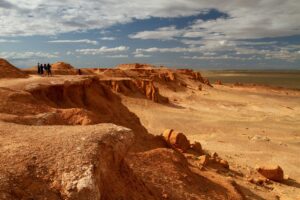
Mongolia’s Gobi is the largest desert in Asia and the fifth largest desert in the world. The Gobi Desert, located in the southern part of Mongolia, is diverse in nature, climate, and topography, and has numerous rare animals and plants. In Particular, Nemegt Mountain, located in Umnugobi province, is famous for the many discoveries of rare dinosaur fossils in its territory. Moreover, Khongor Sand is one of the few locations worldwide with breathtaking dune formations. There is also an oasis, the source of Gobi’s drinking water. The picturesque oasis form the northern rings of the Gobi desert. The Ekhiin River lies in the southern parts of Gobi and is surrounded by an isolated barren desert; however, many vegetables and fruits such as tomatoes, cucumbers, watermelons and peppers grow here. One of the most important vegetation features of Mongolia’s Gobi Desert is the saxaul tree, the only plant that can grow in all ecosystems of the Gobi desert. A trip to the Mongolian Gobi will surely leave you with unforgettable memories.

Meet the Gobi Bear, Mazaalai
Various rare animals live in Mongolia. For example, the Gobi bear, an endangered species recorded in the Red Book of Mongolia, can be spotted in the Gobi region . There are only 26 “Mazaalai” bears left in the world. Gobi bears feed on plants such as gobi nitraria fruits, rheum nanum roots, leaves, bamboo, shrubs, and tamarisk leaves. Gobi bears are uniformly brownish – brown in summer but turn dull and brownish- gray in winter and spring. From November to March, they hibernate in rock caves, tunnels, bamboo groves, under thickets and holes, and they live near open water in summer. Snow leopards also live in Gobi region. More than half of the world’s snow leopard population is found in Mongolia, and the natives are committed to protecting the severely depleted snow leopard population.

